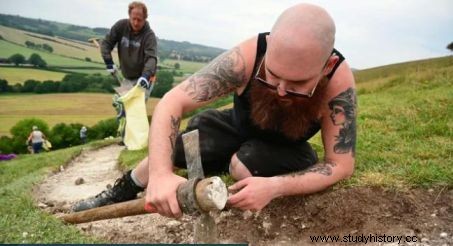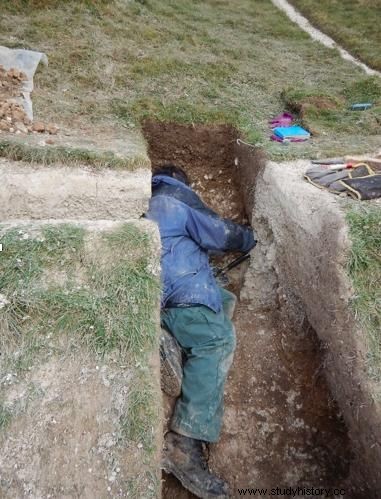In Britain, analyzes underway to determine the age of the enigmatic Cerne Abbas colossus have just delivered their very first results:the famous giant figure carved in chalk probably dates back to the Middle Ages.

The Cerne Abbas Giant in Dorset, UK.
228 meters of linear development under the sky! Naked, erect, club in hand... The giant from Cerne Abbas, UK, lets nothing of his anatomy hide! But since when has his effigy spread over the chalky hills of Dorset in the south of England? This is the question posed by a team of archaeologists from the University of Gloucester, which, after having started a series of samples to try to date it in April 2020, have just obtained their first results. . And the giant does not date back to prehistoric times, as some had hoped!

A National Trust volunteer, during a restoration of the Cerne Abbas Giant figure, in 2019. © National Trust
For centuries, this character had indeed mystified the curious. No one was quite sure how long the 55m-long colossus stretched across the steep hillsides that dominate the village of Cerne Abbas. The land on which it unfolds belongs to the National Trust, a heritage organization, which in 1920 received this land from the hands of a famous family of landowners. Since then, volunteers have regularly taken care of its maintenance, as in 2019 when 17 tons of chalk were brought in to caulk its layout and restore its shine.
OSL dating and snail shells
Celtic deity? Realization of Roman, Saxon, medieval times? Schoolboy joke? There were indeed many questions about him. The naked giant has only been known in the texts since 1690. In an attempt to unravel its mystery, the National Trust - which wanted to celebrate 100 years of its acquisition - joined forces with the University of Gloucester to proceed to its dating. Professor Philip Toms, an archaeologist in the Department of Environmental Sciences, first used the dating method known as OSL (Optically Simulated Luminescence). This technique applies to minerals and measures the time elapsed since they were last exposed to sunlight. To do this, he made incisions at different points of the giant figure to take about ten soil samples from deep inside, in order to submit them to a battery of tests and find out when they were buried. "These dates are still pending, due to delays due to the Covid-19 pandemic and the closure of universities and laboratories", explained archaeologist Mike Allen, specialist in the evolution of the environment and coordinator of this research, joined by Sciences et Avenir.

Taking samples on the route of the Cerne Abbas Giant, for the micromorphological study of the soil. ©J. Gardiner
On the other hand, it is from the analysis of microscopic land snail shells (2mm) present in the soil that the new results came. The latter indeed suggest that the chalk giant probably dates back to the Middle Ages. "These snails arrived accidentally in Britain during the 13th-14th century, probably in straw or hay used to wrap goods from the continent ", clarified Mike Allen. "Some species of snails do indeed live in dark woods, others in tall grass, grazed grass, or some in plowed soil… Analyzing them is a great way to understand the history of changing land use at archaeological sites."
